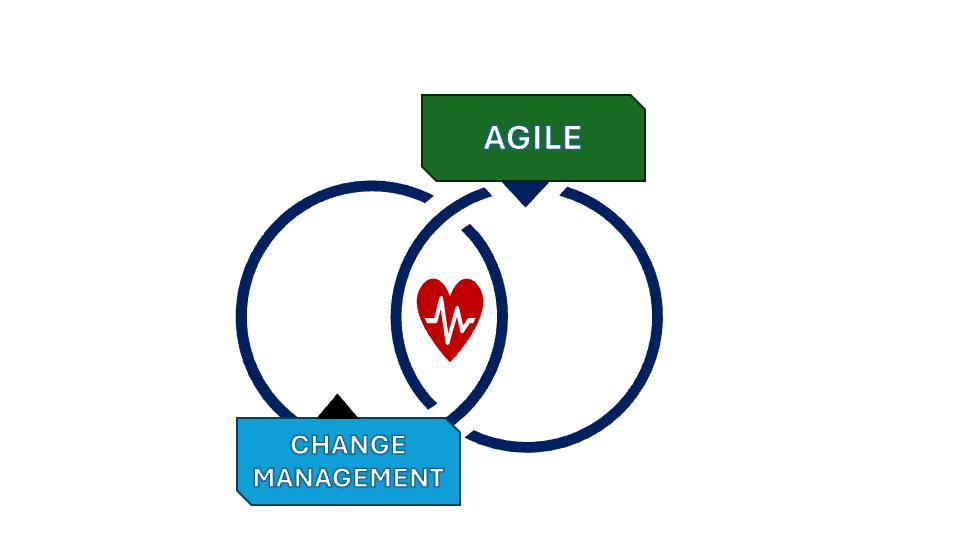Agile & Change Management Are Friends with Benefits
Leverage both for success

What did change management say to agile? “Sorry, I can’t see you anymore.” Was change management just looking to find a new partner, because agile looked a little dusty? Not all that long ago I was in a huge workshop with a PhD. in Change Management, and we were working with leadership on scaling. The good doctor told me I could “have my little agile thing,” but he was responsible for changing the toxic male culture within this organization. Was I mad? Nope. Because You Know That Was a Bad Opening for the Change. A true leader is a coach, always looking to collaborate, even with someone they maybe wouldn’t interact with personally. And collaboration includes looking for the middle ground on what is shared, and then working out the differences and ownership.
When you ask people (whose area of expertise is neither agile or change management), what IS agile and change management? They often come back with, “Agile is just a method for project management, like a framework such as SAFe. Change Management might be reduced to mere communication, like informing employees about upcoming changes that might impact them via email. Uh, ouch! Those answers are truly a YES AND moment. Both areas have a lot of ‘splainers on their team, and frankly people are sick of it. “Be the Change You Want to See.” Once both disciplines move past educating people, the implementation can provide valuable results from both.
The short answer is that both disciplines ARE related, putting PEOPLE first.
Agile and Change Management: A Match Made in Organizational Heaven
In the ever-evolving landscape organizational goals, agile and change management emerged as two separate entities with their own distinct roles and methods. These two are not just compatible but can be incredibly synergistic when they work together. Think of it in terms of a relationship where both parties bring their unique strengths to the table for creating a partnership that benefits the organization and equates success. This is systems thinking at its finest, value streams of the human variety.
Breaking Down the Myths:
Agile is for Software
While it’s true that agile originated in the realm of software development, the values and principles have proven to be incredibly effective across a wide range of organizational functions. Agile is not a methodology; it’s a growth mindset rooted in four core values and twelve principles. It emphasizes continuous, incremental improvement, transparency, and a people-first approach. Agile frameworks are designed to adapt to change, enabling teams to respond quickly and effectively. Agile itself can benefit various aspects of a business.
At its core, it's about fostering an environment that supports people feeling safe to share their ideas, encourages collaboration, and focuses on delivering value. This mindset can be applied to any team or department, not just those involved in software development. It’s about being adaptive, responsive, and continuously improving, which are valuable qualities in any business context. Frameworks like Scrum or LeSS are windows to provide the transparency needed for decision making.
Agile isn’t just for IT, but for all Teams, Executives Included
Agile has a broader application in areas such as HR, Marketing Audit, Finance and Product Management. Its four core values and twelve principles can be adapted to all organizations:
- Collaboration Over Negotiating.
- Responding to Change Over ONLY Following a Plan
- Delivering Working Solutions
- Individuals and Interactions Over Processes and Tools
Change Management Is More than a Documented Communication Plan
It encompasses all the actions and strategies necessary to help individuals navigate and embrace change in the workplace. It’s about understanding human behavior and guiding people through the emotional and practical aspects of change to ensure successful transitions. While change management doesn’t have a single set of universally accepted principles, like agile, uses frameworks/models with foundational principles (ADKAR, Kotter’s, Lewin’s and more)
- Understanding the Change: Clearly define and assess the impact of the change.
- Engaging Stakeholders: Communicate transparently and gather feedback.
- Vision and Strategy: Develop a clear vision and strategic plan.
- Support and Training: Ensure leadership commitment and provide necessary training.
- Managing Resistance: Address and mitigate resistance effectively.
- Implementation and Monitoring: Execute the change, track progress, and adjust as needed.
- Reinforcement: Celebrate successes and integrate changes into the culture.
The Synergy of Agile and Change Management
Both agile and change management prioritize people at their core. Agile focuses on iterative creation and feedback, which helps teams continuously improve and adapt. Change management ensures preparation and impact of changes are communicated effectively and that individuals are supported throughout the transition. When combined, these approaches create a robust framework for managing both the technical and human aspects of change.
For instance, agile’s iterative approach allows for continuous feedback and adjustment, which aligns well with change management’s focus on addressing people’s concerns and adapting strategies as needed. Together, they create a dynamic environment where changes are implemented smoothly, and people are engaged and supported throughout the process. Having an experienced coach will help you with both.
Change Management Plan Integrated with Agile Principles
Using Agile’s twelve principles as a foundation for a change management plan can help create a structured yet flexible approach to managing organizational change. Below is a change plan that integrates each of the agile principles to ensure that the change process is iterative, people-focused, and adaptable.
- Customer Satisfaction Through Early and Continuous Delivery: Aim for quick wins and regular feedback to adjust the change process.
- Welcome Changing Requirements: Design the change process to be flexible and iterative.
- Deliver Working Solutions Frequently: Implement changes in manageable increments.
- Collaboration Over Negotiation: Foster close, cross-functional collaboration throughout the change.
- Build Around Motivated Individuals: Empower teams with resources and recognition.
- Face-to-Face Communication: Prioritize direct, real-time communication for effective problem-solving.
- Measure Progress by Working Solutions: Focus on tangible outcomes rather than activities.
- Maintain a Sustainable Pace: Ensure the change process is manageable and balanced.
- Focus on Excellence and Design: Apply high standards and continuous improvement.
- Simplify Processes: Streamline change processes to maximize efficiency.
- Self-Organizing Teams: Allow teams to make decisions and adapt their approaches.
12. Reflect and Adjust: Regularly review and refine the change process based on feedback.
Moving Beyond the Basics
To truly harness the power of both agile and change management, organizations need to move past basic definitions and certifications without any measurable benchmarks put in place and embrace a more integrated approach. This means not only educating managers and makers about the principles of both disciplines but also creating concrete strategies that leverage their strengths. Leaders who foster collaboration between agile and change management professionals create a successful space for the planning and implementation of their vision.
To sum it up, agile and change management are more than just methods, frameworks, or a distribution email; they are essential components of a successful organizational strategy. By understanding and embracing their complementary roles, organizations can navigate change more effectively, improve their processes, and ultimately achieve greater success. Let’s celebrate the partnership between Agile and Change Management, recognizing that together, they are indeed friends with benefits.


